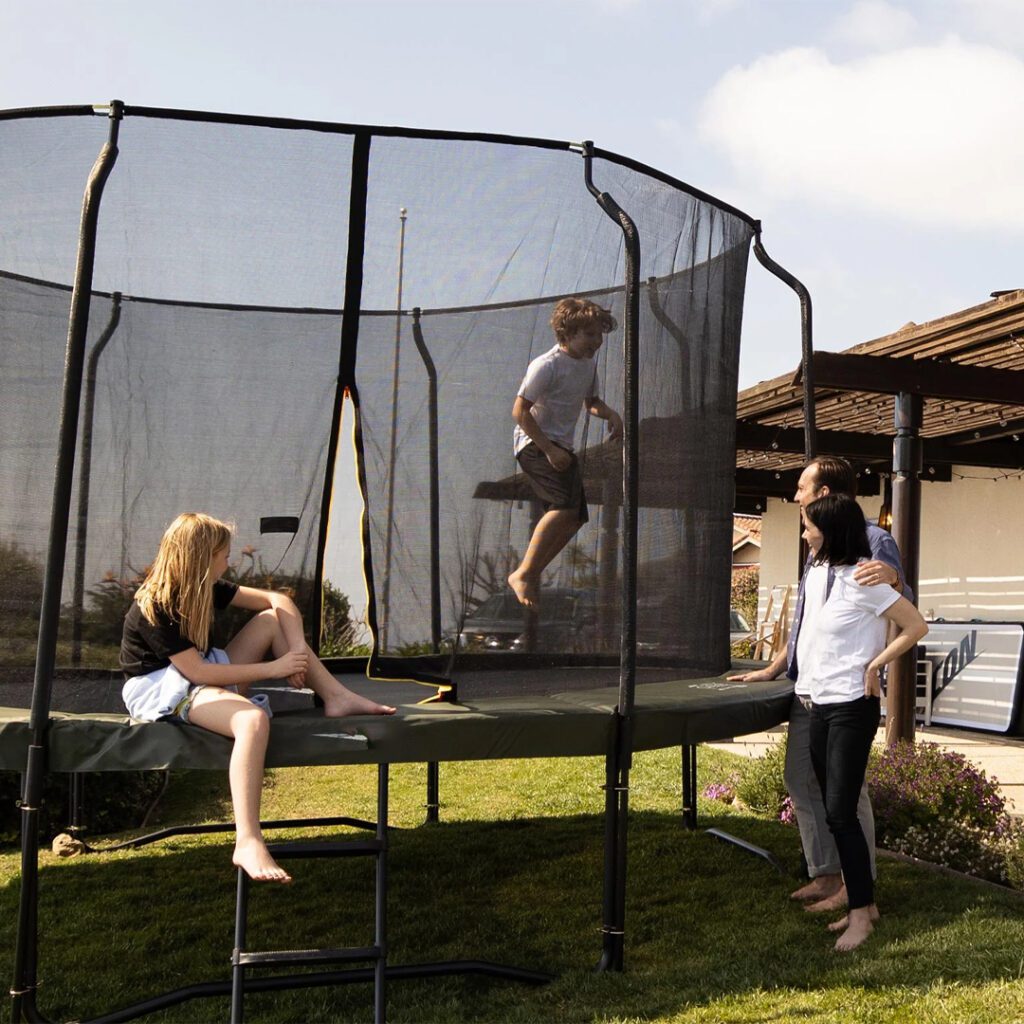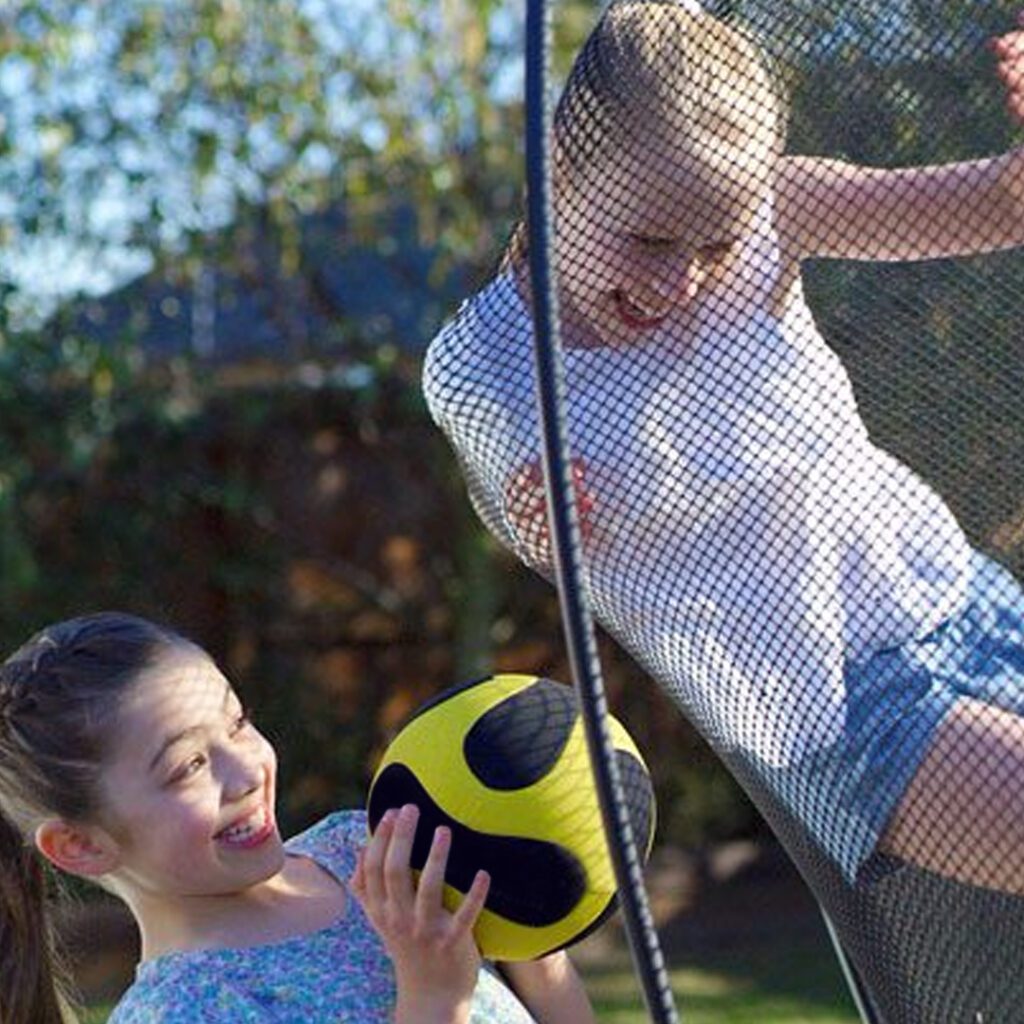
As a parent today, you’re likely familiar with the constant struggle to limit your children’ screen time. Between smartphones, tablets, gaming consoles and streaming services, it can feel like an uphill battle. Too much screen time is associated with issues like childhood obesity, sleep problems, and behavioural issues. But getting your children to unplug and go outside can be easier said than done.
One solution is to provide an engaging outdoor activity to lure your children away from their devices, like a family trampoline. Trampolining provides an exciting opportunity for exercise and outdoor fun that both children and parents will enjoy. Within minutes of bouncing, endorphins are released, improving your mood and reducing stress and anxiety. Trampolining is also a great way for families to bond over an activity they can do together.
In this blog, you will learn about family trampoline and how it helps to cut off the screen time and provide benefits to your children.
The Problem: Screen Time and its Impact

Spending too much time staring at screens has real health implications for children. Their eyesight can deteriorate from constant close-up focus and exposure to blue light. Back and neck problems may develop from poor posture and inactivity. Lack of physical activity and outdoor time also contribute to issues like insomnia, anxiety, and weight gain in children. The more time children spend on screens, the less time they have for exercise, social interaction, and sleep—all of which are essential for proper growth and development.
Poorer Academic Performance
Excessive screen time, especially recreational use of devices, displaces time that could be spent on educational activities like reading, doing homework, and studying. This can negatively impact a child’s academic achievement and success in school. Research shows a link between higher screen use and lower scores in maths, reading, and science.
Impaired Social Development
Spending too much time interacting with screens means less time interacting with real people. This can stunt the development of social skills like communication, empathy, and conflict resolution that children learn from in-person social interaction and play. Excessive screen use is associated with increased risk of behavioural issues, anxiety, and depression in children and teens.
Reducing screen time and encouraging more outdoor physical activity and social interaction can help address these issues. Setting clear limits around technology use, offering alternative options for entertainment and leisure, and leading by example with your own device use are all effective ways to help get children off the screens and encourage healthier habits and development. The benefits of less screen time and more active play will have lifelong impacts on your child’s wellbeing.
The Benefits of Family Trampoline

Trampolining is a fun way for the whole family to get some exercise and improve heart health. Just 30 minutes of bouncing on a trampoline provides an intense cardio workout equal to an hour of jogging! You can even use a family trampoline on special occasion. Regular trampolining can help lower your risk of heart disease by strengthening your heart muscle.
Stronger Muscles and Bones
Bouncing on a 14ft trampoline provides a low-impact workout that strengthens muscles throughout your body, especially your core and legs. It helps build balance, coordination and flexibility. Trampolining can also help build bone density, which is especially important for children and teens. The gravitational forces during trampolining stimulate bone growth.
Stress Relief and Improved Mood
Trampolining releases feel-good hormones like endorphins that act as natural mood boosters and stress relievers. Bouncing can help clear your mind and lift your spirits. The repetitive motion and impact provide sensory input that leads to a calming, meditative effect. Trampolining with family and friends can also strengthen your social connections and relationships, leading to greater happiness and life satisfaction.
Increased Focus and Learning
Trampolining helps stimulate the vestibular system, which contributes to balance, spatial awareness and cognitive development. Bouncing helps make new neural connections in the brain that support focus, concentration, coordination and skill building. Trampolining may even enhance creativity by activating both sides of the brain. Children who take trampoline breaks tend to be more on-task and better able to learn.
In summary, trampolining provides significant benefits for both the body and the mind. Getting your family bouncing and off their screens even just a few times a week can lead to improved health, stronger relationships and enhanced learning and development. The benefits of family trampoline time far outweigh any downsides. Turn off the TV and devices and get bouncing!
Family Bonding Through Bouncing

As a family, trampoline time means creating lasting memories together through unplugged play. Turn off the TV, tablets and phones and make bouncing your sole focus. Laugh together as you try crazy tricks and flips, play games like “popcorn” (where one person bounces and the rest try to make them fly up extra high!), or just chat as you gently bounce and gaze up at the sky. These are the moments that bond families together and create nostalgia for years to come.
Learning Teamwork
If your trampoline has safety nets, you can try group bouncing games that require cooperation. For example, try to get everyone bouncing in sync or pass an object around without dropping it. These kinds of activities teach children how to work as a team to achieve a goal. They also help build communication skills as you call out to each other. Bouncing together is a fun way for both children and parents to practise patience and support.
Exercise and Health Benefits
While bouncing is fun, it also provides some great health benefits for the whole family. Just 15-20 minutes of jumping can burn 200-300 calories, which makes trampoline time a perfect opportunity for some quality exercise. The low-impact, high-energy nature of trampolines is easy on joints but provides an aerobic workout. The buoyancy you experience while bouncing helps decompress the spine and improves flexibility and balance. For children, trampoline exercise helps build strong bones and muscles.
Trampoline time with family provides so many benefits beyond just physical activity. Unplug, laugh, build memories and learn the value of teamwork by bouncing together. Make it a priority to schedule in trampoline time each week, and your family bonds are sure to strengthen and soar.
Setting Boundaries on Screen Time

The first step is to establish clear rules around screen time and enforce them consistently. For example, no screens during dinner time or for 1 hour before bed. Be very specific, even determining which devices are allowed and which are off-limits. Explain your reasoning to your children so they understand why the limits are important.
Lead by example
Are you constantly checking your phone or watching TV? children often mimic parents’ behaviour. Limit your own screen time when your children are around. Put away devices at mealtimes and during family activities. Suggest fun alternatives like playing outside, reading, crafts, or board games. Your good habits will rub off on them.
Offer alternatives
Simply telling children to turn off the screens won’t work if you don’t provide other engaging options. Have toys, games, sports equipment, and craft supplies on hand. Play with your children by going outside for a bike ride or game of catch. Their boredom and restlessness will fade once they get involved in other pursuits.
Monitor use and set timers
Especially for younger children, closely monitor how much time they spend with technology. Use parental controls to block or limit certain apps and websites. Set timers for how long screens can be on, and give children plenty of notice before time is up. As they get older, teach them time management skills so they can self-regulate better.
Reducing screen time and balancing it with exercise and social interaction is vital for children’s wellbeing, growth, and development. With patience and consistency, you can curb technology overuse and inspire your children to live active, healthy lifestyles. Don’t be afraid to set limits—they will thank you for it later!
Addressing Safety Concerns

Every family worries about their children’s safety, and trampolines do come with risks that are important to consider. The good news is, with proper precautions and supervision, trampolines can be enjoyed safely.
- To start, always follow the manufacturer’s recommendations for maximum weight limits, number of jumpers, and proper protective trampoline padding. Protective pads should cover all springs, hooks and the edge of the jumping mat.
- Enforce a “one jumper” rule and teach children to always look before bouncing to avoid mid-air collisions.
- Proper supervision is key. An adult should always be present and actively watching while children are jumping. Spotters can help ensure children don’t attempt any dangerous stunts or tricks and can assist if a child loses their balance or falls off the trampoline.
- Establish ground rules against rough play, somersaults or flips. These movements can easily lead to sprains, fractures or worse.
With the proper safety measures in place, trampolining can provide hours of enjoyment and exercise for your children and bring families together. But vigilance is important – if risks seem to outweigh rewards, it may be better to avoid a trampoline altogether in favour of other fun activities. The most important thing is keeping your children safe and healthy.
Conclusion
A family trampoline can get children off their screens and bouncing in no time. All it takes is investing in a quality trampoline, setting some fun ground rules, and encouraging active play. Don’t be afraid to jump in yourself – it’s a fabulous way to bond and get moving as a family. With a bit of creativity, you can turn trampoline time into a fun daily ritual. Those devices will be forgotten in favour of flips, games and giggles. The bouncing will help your children sleep better too.





